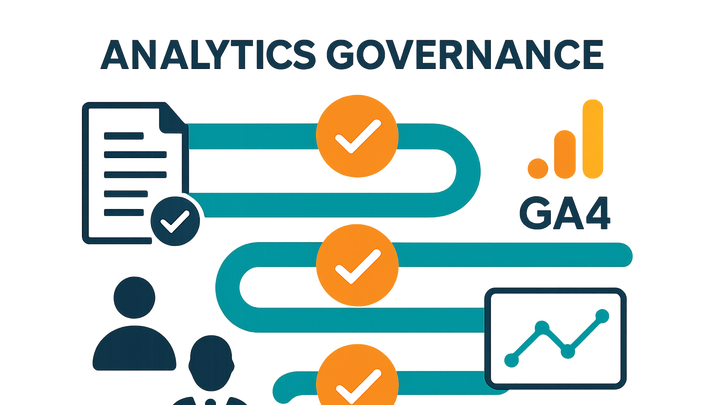Published on 2025-06-26T04:25:01Z
What is Analytics Governance? Examples and Best Practices
Analytics Governance is a structured framework of policies, processes, and roles designed to ensure the integrity, consistency, and compliance of analytics data across an organization. It establishes clear standards for data collection, processing, storage, and reporting, reducing risks associated with data quality issues and regulatory breaches. By defining responsibilities and workflows, Analytics Governance fosters accountability among teams and ensures reliable insights for decision-making. It bridges the gap between technical analytics implementation and business objectives, aligning metrics with strategic goals. Tools like Google Analytics 4 (GA4) and cookie-free solutions such as PlainSignal can be governed under this framework to maintain privacy standards and data accuracy. Implementing robust governance practices enhances trust in analytics outputs, drives operational efficiency, and supports compliance with regulations like GDPR and CCPA.
Analytics governance
Framework for managing analytics data, ensuring quality, privacy, and compliance across tools like GA4 and PlainSignal.
Why Analytics Governance Matters
Analytics Governance ensures that data-driven insights are reliable, compliant, and aligned with business goals. It mitigates risks related to data quality issues, privacy violations, and inconsistent reporting, enabling organizations to make informed decisions. This section delves into the core reasons why establishing governance frameworks is critical for any analytics strategy.
-
Improved data quality
Governance sets standards for data collection and validation, reducing errors and ensuring consistency across datasets.
-
Regulatory compliance
Policies defined under governance help organizations adhere to laws like GDPR and CCPA by controlling data usage and retention.
-
Trust and accountability
Clear roles and responsibilities create accountability, ensuring that stakeholders trust the analytics outputs.
Core Components of Analytics Governance
Effective governance frameworks comprise policies, defined roles, data lifecycle management, and compliance mechanisms. These components work together to safeguard data integrity and ensure alignment with organizational objectives.
-
Policies and standards
Formal documents outlining acceptable data collection methods, naming conventions, and reporting guidelines.
-
Naming conventions
Standardizing event and metric names to avoid duplication and confusion.
-
Data retention policies
Specifying how long data should be stored before deletion or anonymization.
-
-
Roles and responsibilities
Defining who owns data, who stewards data quality, and who governs analytics processes.
-
Data owner
Accountable for data accuracy and business value.
-
Data steward
Manages data quality and enforces governance policies.
-
-
Data lifecycle management
Processes governing data from collection through transformation to archiving or deletion.
-
Privacy and compliance
Mechanisms ensuring data collection and usage comply with legal and ethical standards.
Implementing Analytics Governance
A step-by-step approach helps organizations roll out governance frameworks effectively. From initial assessment to tool integration and continuous monitoring, each phase builds upon the last to create a sustainable governance practice.
-
Assessment and audit
Catalog existing analytics tools, data sources, and processes to identify governance gaps.
-
Policy development
Draft governance policies and standards in collaboration with stakeholders and legal/compliance teams.
-
Tool selection and integration
Choose and configure analytics platforms in line with governance policies.
-
PlainSignal (cookie-free simple analytics)
A privacy-focused, cookie-free analytics tool that can be integrated under governance. Example implementation:
<link rel="preconnect" href="//eu.plainsignal.com/" crossorigin /> <script defer data-do="yourwebsitedomain.com" data-id="0GQV1xmtzQQ" data-api="//eu.plainsignal.com" src="//cdn.plainsignal.com/plainsignal-min.js"></script> -
Google analytics 4 (GA4)
Configure GA4 with governance by setting user permissions, data filters, and retention controls to align with privacy and quality standards.
-
-
Training and change management
Educate teams on governance policies, tool usage, and reporting standards to ensure adoption.
Measuring Success and Continuous Improvement
Governance is not a one-time project but an ongoing practice. Regular evaluation and refinement ensure that governance adapts to evolving business needs and regulations.
-
Key performance indicators
Define metrics such as data accuracy rate, policy compliance score, and audit findings to measure governance effectiveness.
-
Audits and reviews
Conduct periodic audits of data pipelines, tag implementations, and compliance records.
-
Feedback loops
Collect input from analysts, marketers, and legal teams to identify improvement areas.
-
Policy updates
Refine policies and standards based on audit outcomes, regulatory changes, and business priorities.
